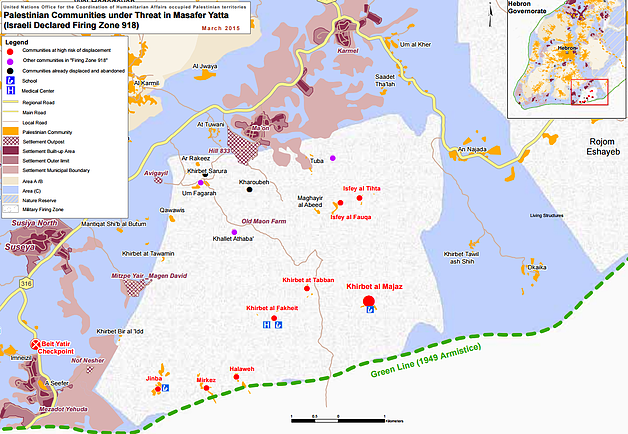Sharp decline in demolitions and related displacement in Area C during February
Humanitarian assistance provided to vulnerable communities served with stop-work orders
In February, the Israeli authorities demolished 17 structures in the West Bank on the grounds of lack of building permits. All of the targeted structures were livelihood-related or uninhabited, resulting in no displacement. This is the lowest number of demolitions recorded since July 2014 and the first month without demolition-related displacement since August 2011.
All but two of this month’s demolitions were recorded in Area C of the West Bank, mainly in the Jerusalem (6), Hebron (4) and Nablus (4) governorates. These include two agricultural rooms and a water cistern in the village of Qusra (Nablus), and an irrigation pool in An Nuweimeh, all funded by international donors and affecting some 160 people.
In a separate incident on 18 February (not included in the total above), the Israeli authorities confiscated a concrete mixer funded by the Emergency Relief Fund (ERF) for the renovation of water cisterns in the community of Tell al Khashaba (Nablus, also known as Al Twayel), located in a closed military “firing zone”. The community is not connected to the water network and residents (250 people) rely on rainfall collection and the purchase of expensive tankered water to meet their domestic and livelihood needs. During 2014, Israeli authorities demolished 41 structures in this community, of which 16 were donor-funded, including an electricity network. Over 100 people were displaced.

This month saw a worrying increase in the number of donor-funded structures served with stop-work orders. Of the 27 structures placed at risk of demolition, 15 are located in the Palestinian Bedouin community of Hathroura (previously called Wadi al Qilt Ka’abneh, pop. 130). Eviction orders served initially on these structures were revoked following a legal intervention and replaced with stop-work orders, which entail a longer legal process prior to execution. Hathroura is one of the 46 Bedouin communities (pop. 7,000) in the central West Bank at risk of forcible transfer in an Israeli “relocation plan”.
The Israeli authorities also began leveling and other infrastructure works this month in a section of Al Jabal (Jerusalem) - one of the three sites designated for the Bedouin relocation and which can accommodate approximately 50 families. The planning scheme for this part of the site has been endorsed and building permits issued. This site is adjacent to the current homes of another 150 Bedouin families “relocated” in the late 1990s to make way for the expansion of the Ma’ale Adumim settlement.
Other donor-funded assistance targeted this month included a prefabricated school, three mobile latrines and a drinking fountain in Khirbet al Majaz (Masafer Yatta area, Hebron). This is one of eight communities located in an area designated as a “Firing Zone 918” also at risk of forcible transfer.
Online demolition tracking system launched
This month, OCHA launched an online system for humanitarian partners to track the demolition and confiscation of Palestinian property in the West Bank by Israel. It is designed to monitor humanitarian needs emanating from such incidents to allow a timely and targeted humanitarian response. The system features up-to-date information, including a full assessment and summary of needs for each incident. Information on responses is logged every two weeks. Three customized dashboards allow users to monitor responses and identify gaps. The system is unique in its integrated and collaborative nature, allowing humanitarian partners to rely on an integrated and agreed data set.
Click here to access the tracking system.









